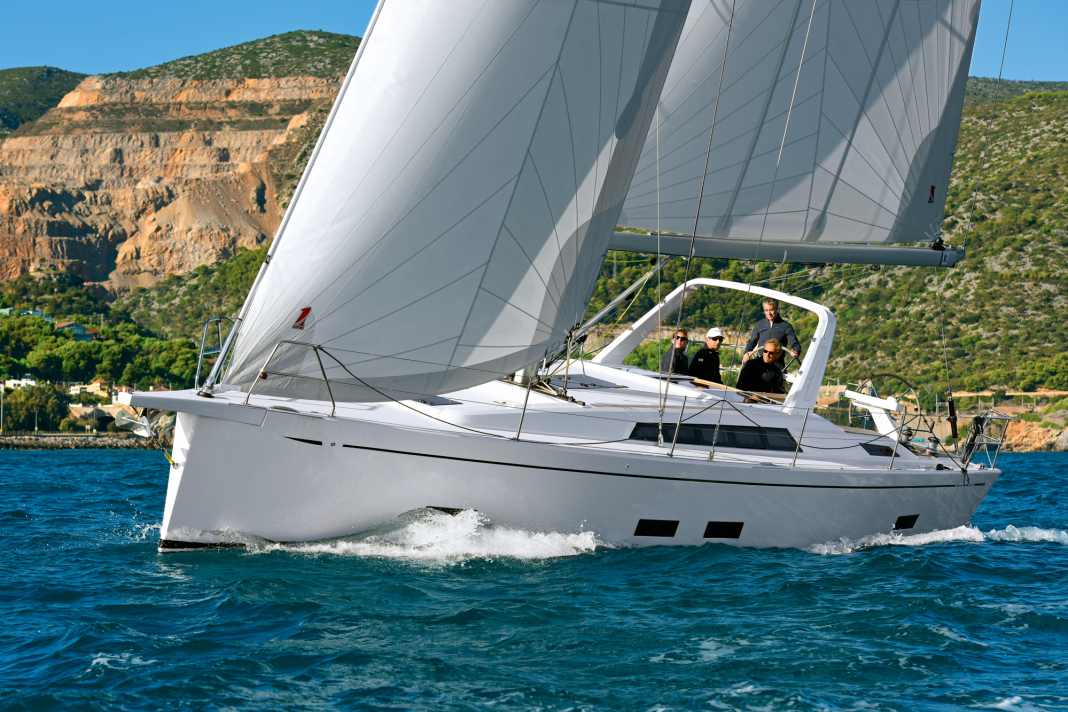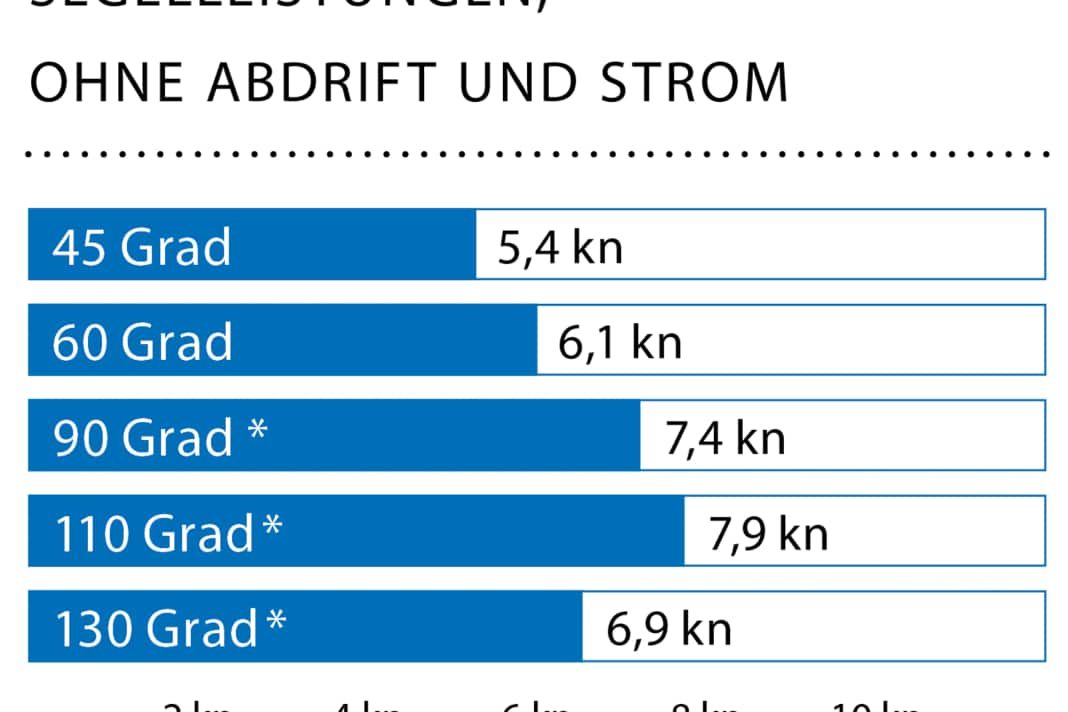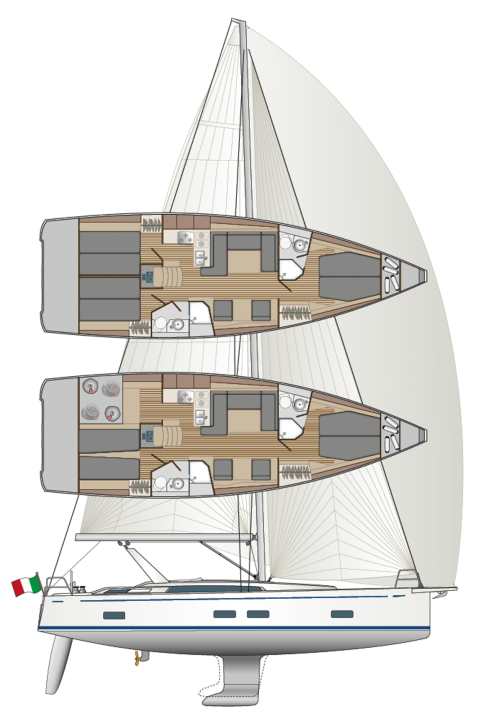





It is the youngest and smallest yacht in the series, with which the fine Italian brand aims to appeal to comfort-orientated owners. LC stands for Long Cruise, a somewhat unorthodox translation for long voyage. The term "cruising" would be even more appropriate, as the Grand Soleil is not intended for adventure cruises in high latitudes.
Shipyard owner and mastermind Gigi Servidati designed the elegant cruiser more for the Mediterranean and for ocean passages in the Passat. He deliberately allowed an unusually wide range of options: the 13-metre yacht can be configured from a pure cruising boat with a furling main, self-tacking jib and cockpit bow to a sports version with a higher aluminium mast, rod rig, significantly more sail area and open stern.
Few production yards offer this level of customisability - especially as Cantiere del Pardo is also pushing ahead with the development of an independent model that is more optimised for regatta sailing: the Grand Soleil 44 Performance announced for this summer.
The boat builders from Forli, not far from Rimini on the eastern side of the Italian peninsula, thus cover an extremely broad spectrum - from tourers to racers. Gigi Servidati, who has been familiar with the market for decades, explains the strategy as follows: "Owners in the upmarket segment today expect a boat that exactly fulfils their expectations. We couldn't fulfil this demand with just one model and a few options."
Wide range: standard or sports version
The 42 LC is exceptionally versatile. In the "Sport" version shown above (surcharge), she not only looks elegant and racy; she also carries almost 15 per cent more sail area upwind. The standard version, on the other hand, is more massive in appearance due to the bow in the cockpit and the higher bathing platform, and offers more storage space and practicality.
Not only is the mainsheet attached to the carbon fibre support structure that spans the cockpit; the sprayhood and bimini can also be attached to keder rails here, providing the crew with excellent protection from the sun and spray. You have to imagine the boat as a modern luxury SUV - with plenty of space and comfort, plus plenty of power, which is also available lowered and with a few extra horsepower on request.
The 42 LC does not lack temperament even in the basic configuration. Designer Marco Lostuzzi has moved the mast a little further aft than on the larger sister models, resulting in a long J dimension. As a result, the self-tacking jib alone has a sail area of 43.5 square metres; a Genoa 3 sheeted on the coachroof measures 49.5 square metres on the standard mast. For heavy weather, a strong wind jib with an area of 18 square metres can also be used on the removable cutter stay - a recommended option for offshore sailing.
Sailing performance and operability of the Grand Soleil 42 LC
The Grand Soleil showed respectable sailing performance in the test. With standard rigging and sails, she reached a speed of around 5.5 knots in a moderate breeze. With a light aft wind and under Code Zero, she logged around 8 knots during our measurements. She was sufficiently direct and responsive on the helm. Even with more pressure, a good 5 Beaufort on average, she willingly followed every steering impulse under full sail. The boat then logged 7.5 knots at the cross and, with wave support, sometimes even briefly started planing with speeds through the water of between 9 and over 11 knots.
The 42 LC sails surprisingly stiffly. On the one hand, the L-keel with lead bulb ensures a low centre of gravity, and on the other, the wide stern provides a lot of dimensional stability. Even in rough seas, its behaviour is not rough, but balanced and predictable. This distinguishes it favourably from sportier boats with a more extreme frame shape and lower displacement.
The cockpit geometry is also a success. The two helm stations are positioned far outwards, allowing a good view of the sails and waves. When seated, the helmsman can safely rest one foot against the pillar protruding from the coaming. Trimming is not a problem either, as the mainsheet is led aft to separate winches on both sides and the self-tacking jib hardly causes any work.
Deck layout with advantages and disadvantages
Only the distance between the stoppers and the aft drums is a little too long to be bridged safely from the helm; you really have to stretch yourself. However, this shortcoming is only noticeable when changing sails or reefing. If you want to make your work easier, you should choose two winches with electric drive (extra charge). They seem particularly useful for those who frequently set genoa, gennaker or code zero, because their surfaces otherwise require a hearty tug when cranking the seal.
The side cockpit coamings are a little tight, especially as they slope down towards the winches; they hardly allow you to lean against them comfortably and safely at sea. This is only possible if you sit against the direction of travel and with your back to the cabin wall. The benches in the cockpit are a comfortable 59 centimetres wide and long enough at 1.94 metres.
The gangway to the foredeck of the 42 LC leads over wide decks and remains unobstructed. The upper shrouds attach to the outside of the hull wall, the lower shrouds to the cabin superstructure - unfortunately not a matter of course today. The two-part storage space in the forepeak is also good. Behind the box for the anchor chain, under the same hatch cover, there is a second, much larger compartment that can also hold the space windsails and fenders. This saves long journeys.
Two or three-cabin extension
The latest Grand Soleil is certainly not small. On the contrary: it offers so much space that it not only stands out against competitor models of the same length, but could also become a rival to the 46 LC from our own company.
Even the basic model with three compartments and two bathrooms lacks nothing. The version with two cabins looks downright lavish, although it costs an incomprehensible extra charge. Here, the aft cabin is wider, the galley longer and the port side locker more than one and a half cubic metres larger. This cabin layout is particularly recommended for owners who want to be travelling for months at a time.
At first glance, the ambience below deck resembles that of many modern cruising boats: functional, geometric - even yachts in the lower price range look like this today. However, the appearance of the 42 LC is of a higher quality, warmer too, and the craftsmanship is better: small gaps and finely varnished wooden surfaces are evidence of this. The ceiling panels are particularly well done: The Whisper decorative textile is stretched over frame constructions, creating a surface that is both soft and very even. Functionally and aesthetically, this is a great solution that has hardly been seen before.
The comfort dimensions are also just right. With headroom of 1.87 to 1.93 metres, the Grand Soleil offers sufficient headroom. The double berths are wide enough throughout. And the storage space is also adequate: a good 400 litres in each of the aft compartments and in the galley, and more than 800 litres in the owner's cabin at the front. Only the rattling Corian cooker cover in rough seas and the harsh engine noise when cruising spoil the otherwise very strong comfort rating.
Overall, the 42 LC scores highly in almost all relevant areas, even in the standard version that we tested. It is not cheap, but justifies the premium surcharge thanks to its many qualities - and the possibility of specifying it very precisely to the requirements profile of its owner.
The measured values for testing the Grand Soleil 42 LC




The Grand Soleil 42 LC in detail

Technical data of the Grand Soleil 42 LC
- Designer: Marco Lostuzzi
- CE design category: A
- Torso length: 12,95 m
- Width: 4,18 m
- Draught/alternative: 2,25/1,80 m
- Weight: 9,5 t
- Ballast/proportion: 2,5 t/26 %
- Mainsail: 52,8 m2
- Self-tacking jib: 43,5 m2
- machine (Volvo Penta): 38 kW/51 hp
Hull and deck construction
GRP sandwich construction using the hand lay-up method, vinyl ester resin. Iron keel fin, lead bomb
Price and shipyard
- Base price ex shipyard: 461,720 € incl. 19% VAT.
- Guarantee/against osmosis: 2/5 years
Shipyard
Cantiere del Pardo SPA, Via Fratelli Lumiere, 34, 47122 Forlì, Italy. www.grandsoleil.net
YACHT rating of the Grand Soleil 42 LC
With the Grand Soleil 42 LC, Cantiere del Pardo has developed a yacht that is extremely customisable to the preferences of its owners. It offers plenty of volume, is cosy, easy to handle and pleasantly agile under sail
Design and concept
- + Sensible options
- + Solid construction
- - Expensive with complete equipment
Sailing performance and trim
- + Quite fast even with S-jib
- + Intuitive rudder feel
- - Heavy-duty genoa furling system
Living and finishing quality
- + Cleanly finished down to the last detail
- + Lots of storage space as a two-cabin vehicle
- + Good longitudinal/cross ventilation
Equipment and technology
- + High-quality fittings
- - Bathing platform too low
This article first appeared in YACHT 05/2020 and has been updated for this online version.

